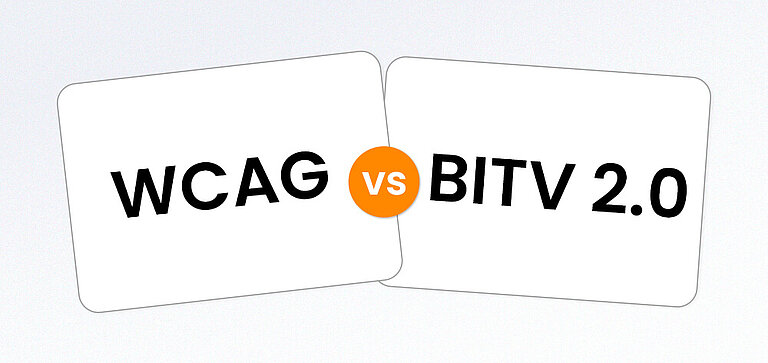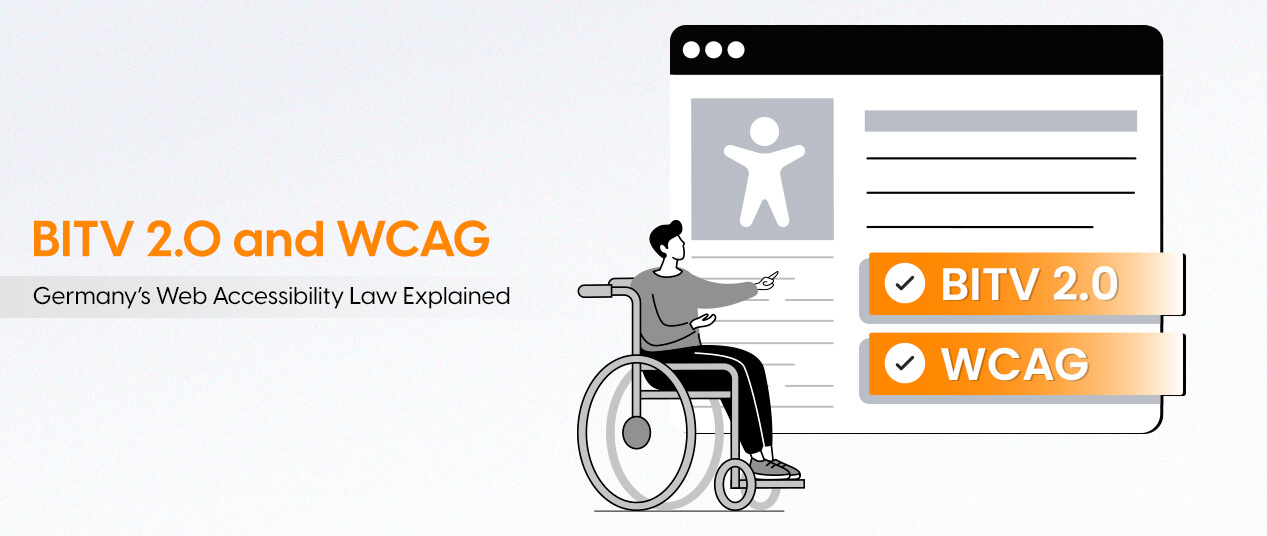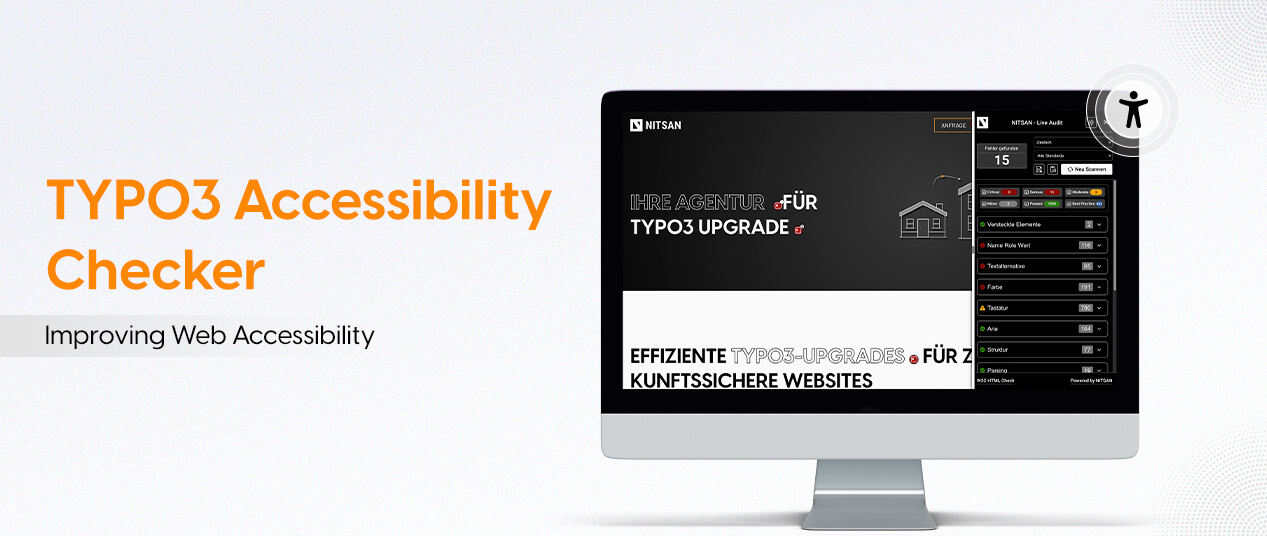What you may not know is how the German BITV 2.0 actually works. It is based on the international WCAG guidelines that many developers and teams already follow.
They are connected. But not the same.
So why is the BITV 2.0 of particular importance? What's different, what's enforced, and who exactly has to comply with it?
In this post, you'll learn how the BITV 2.0 differs from the WCAG and what your organization needs to do to comply!
What is BITV 2.0? Germany’s Accessibility Law
BITV 2.0 is Germany's official regulation on digital accessibility, short for Barrierefreie-Informationstechnik-Verordnung. It explains how websites, apps and digital documents must be designed - for all people, including people with disabilities.
The basis of BITV 2.0 is WCAG 2.1 Level AA. This means that most of the technical requirements are already defined by the international guidelines. But BITV 2.0 adds specific rules that correspond to the German legal system.
The legal basis for this is the Disability Equality Act (BGG), which obliges public bodies to comply. This includes ministries, city councils, universities and other public institutions.
And even if private companies have not yet been fully covered, this is changing. The Accessibility Reinforcement Act introduced new regulations in 2025, particularly for sectors such as banking, e-commerce and transport.
What is WCAG?
WCAG (Web Content Accessibility Guidelines) is the international standard for designing websites and digital services so that they can be used by everyone - especially people with disabilities.
Developed by the World Wide Web Consortium (W3C), WCAG forms the basis for digital accessibility worldwide.
WCAG was first published in 1999, but the most important and most frequently used versions are currently 2.0 and 2.1. The guidelines are based on four simple and practical principles, the so-called "POUR" principles:
- Perceivable - Content must be able to be seen or heard, even if users cannot do both.
- Operable - Users must be able to navigate and interact with a mouse, keyboard or assistive technology.
- Understandable - Information and user interfaces must be clearly legible and predictable.
- Robust - Content should work on different devices, browsers and assistance systems.
WCAG describes accessibility in three levels:
- Level A - the absolute minimum requirements, limited to selected criteria.
- Level AA - the standard to which most laws, e.g. in Germany, refer.
- Level AAA - the highest level, but not realistically feasible for every website.
To meet the legal requirements in Germany, Level AA is the realistic target - a compromise between inclusion and practical feasibility.
BITV 2.0 vs. WCAG: Side-by-Side Comparison

It is important to know that WCAG sets a global standard for digital accessibility. BITV 2.0 takes up these principles and uses them to formulate concrete specifications for Germany.
BITV 2.0 integrates the international specifications of WCAG Level AA as basic requirements. At the same time, BITV 2.0 contains elements specific to Germany in order to strengthen responsibility and protection for users.
Aspect | WCAG 2.1 Level AA | BITV 2.0 |
Origin | Developed by the W3C (international standard) | German ordinance in accordance with the Disability Equality Act (BGG) |
Legal status | Often legally referenced, but not a separate law | Legally binding in Germany for public bodies |
Structure | 4 principles (POUR), 13 guidelines, success criteria | Based on WCAG, but structured according to priority I (mandatory) and II (recommended) |
Conformance levels | A, AA, AAA (AA mostly required) | WCAG 2.1 Level AA as a legal minimum |
Declaration of accessibility | Not required by WCAG | Mandatory for websites and apps of public bodies |
Feedback mechanism | Not an integral part of WCAG | Required according to BITV 2.0 and EU Directive 2016/2102 |
Simple / easy language | Not explicitly required | Strongly recommended, especially plain language for cognitive accessibility |
Scope of application | General best practice worldwide | Websites of public bodies; private companies will have a greater obligation from 2025 |
How Compliance Is Checked
In Germany, accessibility is monitored, tested and documented, and several monitoring bodies at federal and state level are responsible for evaluating digital offerings from the public sector. These tests are based on EU requirements, in particular the Directive (EU) 2016/2102which prescribes regular accessibility reports.
Websites and apps are checked by
- Automated toolsto detect technical problems
- Manual teststo identify usability and navigation obstacles
- User testing, often involving people with disabilities
These tests assess how well a digital offering complies with WCAG 2.1 Level AA, as required by BITV 2.0.
What are the consequences if you’re not compliant?
If your website or app does not meet the requirements, the following consequences are possible:
- User feedback: Any person can submit a complaint via the feedback mechanism - and the organization must respond.
- Legal action: If issues are not resolved, the case may be referred to an arbitration body or supervisory authority.
- Public presentation: The accessibility statement must be publicly available and up to date. A lack of accessibility is therefore visible to everyone - including inspection bodies.
Damage to image: For public bodies, inaccessibility signals that certain citizens do not play a role inside. For companies, it damages their trustworthiness and brand reputation.
Practical Steps for Achieving Compliance
Compliance with BITV 2.0 and WCAG 2.1 Level AA can be achieved by taking the right measures:
1. Perform accessibility testing: Use automated tools like TYPO3 Accessibility Checker to check your website or app, and supplement this with manual testing. Involve real users, especially people with disabilities, to identify real barriers.
2. Fix critical barriers: First fixbasic problems like:
- Missing alt texts
- Poor color contrasts
- Keyboard traps
- Defective navigationIf users cannot reach critical content or functions inside, everything else is secondary.
3. Publish an accessibility statement: Required according to BITV 2.0. Be transparent about your accessibility status, known barriers and contact options. Keep this declaration up to date.
4. Enable user feedback: Provide an easy way for users to report barriers and give feedback. Failure to do so can have serious legal consequences if you do not comply with BITV 2.0.
5. Integrate accessibility into the workflow: Train your team. Embed accessibility firmly into your design, development and content creation processes.
Conclusion
BITV 2.0 and WCAG 2.1 pursue a common goal: to make digital services accessible to everyone.
But this is not just about ticking off a legal checklist. It's about creating digital systems that include and respect all people - regardless of their abilities.
By understanding how BITV builds on WCAG, you can ensure that your implementation goes beyond the legal minimum. The goal is to create digital environments that are functional, inclusive and future-proof.
Accessibility is not an additional task. It is simply good work.
Start with an accessibility audit. Learn more about BITV 2.0 and your responsibilities, and get your team involved. If you don't know where to start, our TYPO3 Agency - NITSAN will be happy to advise you.
For more practical tips and insights around digital accessibility and legal requirements, visit our blog: Accessible Website With TYPO3 Accessibility!

Contact for SMEs, government organizations and BITV 2.0
Stefan Reinhardt
Service Partner - Germany





Be the First to Comment